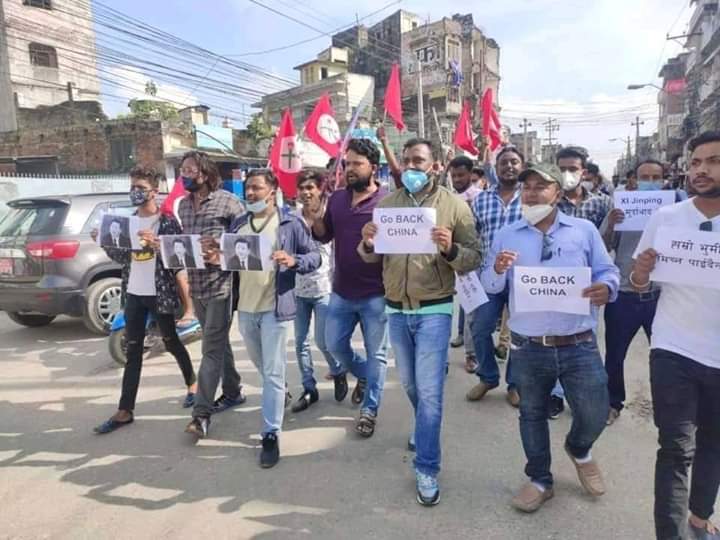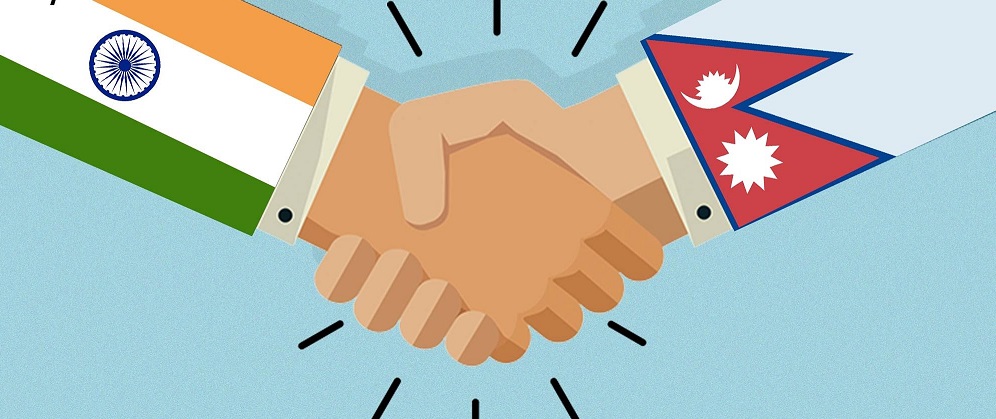Growing Chinese presence in Nepal is a matter of great concern for Government of India.
The 1950–1951 invasion of Tibet by the People’s Liberation Army resulted in significant changes in the Chinese relationship with Nepal. China ordered restrictions on the entry of Nepalese pilgrims and contacts with Tibet and increased its support for the Communist Party of Nepal, which was opposed to the continuation of the Nepalese monarchy. Mao repeatedly stated from 1950 onwards that Taiwan, Tibet, and Hainan Islands were Chinese territories and would be repossessed in time and the predominant trait in this claim was the sudden appearance of “existing maps showing large parts of Korea, Indo-China, Mongolia, Burma, Malaysia, Eastern Turkestan, India, Tibet, Nepal, Sikkim, and Bhutan as Chinese territories.” Later Mao stated publicly that Tibet was the palm of a hand, and its five fingers were Ladakh, Sikkim, Nepal, Bhutan, and North-East Frontier Agency. Worried by this statement in 1952, King Tribhuwan of Nepal invited an Indian Military Mission (IMM) to reorganize and modernise his army which earlier was kept part-time and when not on duty followed other professions. Periodically, they were called for parades in Kathmandu and were ill-equipped and ill-paid.
The IMM arrived at Kathmandu “on February 28, 1952, and was tasked to assist in the reorganization of the Nepali Army, formulating defence plans against internal and external threats, and improving intelligence and administrative establishments. The IMM consisted of a Major General assisted by 20 Indian army officers. In December 1953, its strength was a total of 197, all ranks. On its recommendations, by April 1952, the RNA was downsized from 25,000 ill-organised soldiers to 6000 well trained and equipped ones.
In September 1951, 17 check posts were established along Nepal’s borders with China and were manned jointly by 75 Indian technicians and Nepalese Army personnel. Unfortunately, under pressure domestically and from China, in mid-1958, the King asked India to withdraw the IMM. As a result, India agreed to reduce its strength to 23 in all and to retain it in Nepal under the name of the Indian Military Training and Advisory Group (IMTAG). Further, on June 5, 1969, the Nepalese PM asked for the withdrawal of all the check posts and the IMTAG. The withdrawal of the IMM was completed by August 1970.
India continued to supply arms, ammunition and equipment to the entire Nepalese Army of 17,000 personnel, comprising four re-organised brigades. It catered for the replacement of existing weapons as well as training. After the restoration of amicable relations, post-1989 crisis, the Nepalese sought India’s help in raising large-scale military formations by reorganising the existing army from its battalions and independent companies into brigades and divisions. By 1998, a simmering Maoist insurgency in Nepal forced the Government of Nepal to relook at the equipping of its army and make it capable of fighting these Maoists. Once again Nepal requested assistance from India and a host of other nations including the USA, the UK, and China, the EU, and Pakistan, all of whom reacted in various ways and to equip Nepal with diverse military equipment.” From India, “under a 70% assistance scheme, and through a series of defence-purchase negotiations”, “the Nepal Army (NA) received more than 26,000 weapons of various kinds including 21000 Indian-made INSAS rifles, 81- and 51-mm mortars and other military hardware including landmines, detonators, safety fuses and time pencils. India also provided four Advanced Light Helicopters.
Post the ‘Jan Andolan’ and the agreement of the Government of Nepal and the Maoists, India had supplied non-lethal equipment to include 216 light vehicles, 154 heavy vehicles, including 58 trucks of 7.5 tons capacity, 67 trucks of 2.5 tons capacity, 4 ambulances, and 25multi-purpose armoured vehicles, among others.
India’s Security Concerns in Nepal
Geographical position and historical development are largely determining factors of Nepal’s foreign policy that regardless of the kaleidoscopic change of contemporary events, and no matter what form of government or what political party may be in power, no government in Nepal can ignore the fundamentals of geography. In the end, it must return again and again to the same general and fundamental alignment. This is applicable both in the Indo- Nepalese and the Nepal-China context and is evident in its political relations since the establishment of the modern State of Nepal.
This unique location of Nepal is of immense strategic value to India as well as to China. India has traditionally looked at its northern frontiers with China as the Himalayan watershed. The Himalayan watershed forms formidable military barriers that can be crossed at selected places only and therefore lend itself for a strong defence line requiring significantly lesser resources to defend. Any Chinese military or ideological influx or influence south of this watershed would be inimical to Indian interests and since the mountains of Nepal open out to the great Indian plains, it becomes crucial to safeguard the military interests of India. China, on the other hand, views its borders with Nepal, as the soft underbelly of Tibet. It, therefore, finds it necessary to ensure that it retains adequate political, strategic and economic leverage in Nepal so that its security is not compromised. Nepal’s southern borders with India do not have geographical barriers and are open, porous and in places difficult to monitor by the security personnel. Any anti-India activity in Nepalese border areas will find easy access to a poorly guarded and insecure Indian heartland. These activities could be ISI sponsored violence, smuggling, drug running, and other economic offences. Now with the increase in Chinese influence within Nepal and further its movement towards the Terrai belt bordering the Indo-Gangetic heartland, it’s only a matter of time that China would utilise this open border and exploit this weakness of the Indian state and take advantage of it.
The Chinese Creep into Nepal
“China is many things at once in Nepal today. It is a superpower, a beneficent aid-giver, a friend in need, an essential provider, a demanding neighbour, an older brother, a competitor, a model of development and a vision of a developed future. China is changing regional and global dynamics in an unprecedented way than Nepal. As China declares itself on the world stage, Nepal wants to tag along for the ride. Relations have never been better than in the contemporary era, but they need to be sustained, nurtured and developed as they evolve. It is in Nepal’s interest to do so, and imperative to do it in a way that acknowledged its own aspirations.” – Amish Raj MulmiThis growing influence of China in Nepal especially towards the Terrai bordering India, where it has been given the responsibility of creating or remodelling Lumbini into a world peace city could be a major challenge for India to maintain a balance between the two neighbours.

The Inherent Dangers of the Lumbini Proposal
Lumbini is just 30 km from the Indian border town of Sunauli and at an extremely strategic and critical part of India’s Indo-Gangetic heartland., A Chinese company bringing in Chinese labour which could consist of PLA in disguise is definitely a clear and present danger for India, regardless of the plan to transform Lumbini, the birthplace of Buddha, into an international tourist hub and a ‘Mecca’ for Buddhist pilgrims. What does seem suspect is that a country like China, which has done its utmost to destroy Buddhism and peace in Tibet, has been charged with the responsibility to build infrastructure surrounding Lumbini, a UNESCO World Heritage Site, so as to attract Buddhist pilgrims from over the world.
Changing Perceptions About the Chinese in Nepal
Recently, the Kathmandu Post, an English-language newspaper in Nepal, ruffled Chinese feathers in February when it published an article criticizing Beijing’s handling of the COVID-19 virus outbreak. The article blamed China’s authoritarian political system for contributing to the spread of the virus and turning it into a pandemic. The Chinese Embassy in Nepal immediately put out a statement condemning the Kathmandu Post for its scathing editorial. The embassy threatened to take further action against the newspaper and singled out Anup Kaphle, its editor-in-chief, for being “biased on China-related issues.”
China’s harsh response toward the Nepali newspaper came at a time when Beijing has greatly ramped up its investments in Nepal. Further, the Kathmandu Post alleged that Chinese aid to Nepal comes with “strings attached.” However, a respected academic, Kapil Shrestha, a professor of political science at Tribhuwan University in Kathmandu, agreed with the paper’s view and stated that “Nepalis interpret the embassy’s statement as unwarranted interference in the sovereignty of Nepal. It’s an act of intimidation to the extent that it blackmails Nepal.”
Upgrading Existing Trade with TAR (Tibet Autonomous Region)
Since independence, Nepal was dependent on Indian ports for its commerce, with two-thirds of goods to and from Nepal passing through them. However, in a bid to cut back on this reliance, Kathmandu signed a transit protocol with Beijing in 2017. This protocol, which came into force on February 1, 2018, gave Nepal access to four seaports and three land ports in China and was inked just months after India had normalised the supply of essential items such as fuel and medicines to Nepal. This transit protocol would result in the border between Nepal and China becoming more porous and could be a potential security risk for India.
Conclusion
Post-colonial India wanted a special relationship based on its security umbrella over all three of its Himalayan neighbour-states, Nepal, Bhutan and Sikkim. PM Nehru, in a 1950 speech to the Indian Parliament outlined the Himalayas as India’s “magnificent frontier”, and stated: “We have been inheritors of many good things from the days of British rule, and many bad things also; and our relations with our neighbouring countries grew up sometimes in an expansive phase of British policy, of British imperialism. Naturally, and quite frankly, we do not like, and we do not propose to like, any foreign interference in Nepal… So our relationship is intimate, and no other country’s relationship with Nepal can be as intimate, and every other country must have realised and appreciated this intimate geographical, cultural and other relationship of India and Nepal. There is no way out except by realising this fact.”
Chinese presence in Nepal and its dubious plans are a real security threat to India. The relations of Nepal with China and Tibet reflect, in their vicissitudes, the greater events of Central Asia. Nepal, today marks the extreme limit to where Chinese influence has extended southwards.
Nepal, “being a sovereign country would like to deal with India on an equitable basis. Given the geographically contiguous, culturally similar and economically closer relationship with India, Nepal perhaps also realizes that it would be quite impractical to ignore its southern giant at the behest of building strategic ties with the northern giant. With globalisation, shifting Asian balance of power, the rise of China and the emergence of India, Nepal is likely to opt for a balanced approach with both India and China, which it hopes would eventually pave the path for its own economic growth and stability.
For India, the challenge is to keep Nepal within its sphere of influence without being seen as domineering. In fact, India must deftly handle its Nepal policy keeping in mind the growing Chinese presence in Nepal and deal deftly and swiftly with the emerging security threat to our heartland, the Indo-Gangetic Basin.” There are no soft options left on the table anymore.
Title image courtesy: https://www.thequint.com/voices/opinion/
Disclaimer: The views and opinions expressed by the author do not necessarily reflect the views of the Government of India and Defence Research and Studies.





